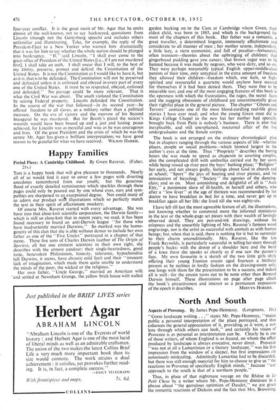Happy Families
Period Piece: A Cambridge Childhood. By Gwen Raverat. (Faber. 21s.) Tins is a happy book that will give pleasure to thousands. Nearly all of us would find it easy to cover a few pages with diverting anecdotes remembered from our youth; but the generous flood of exactly detailed reminiscence which sparkles through these pages could only be poured out by one whose eyes, ears and sym- pathies are sharpened to an exceptional degree. Nor could many of us adorn our product with illustrations which so perfectly match the text in their spirit of affectionate mockery.
Of course Mrs. Raverat started with every advantage. She was born into that close-knit scientific corporation, the Darwin family— which is still so close-knit that in recent years, we read, it has been found necessary to found an anti-Darwin league "for those who have inadvertently married Darwins." So marked was the homo- geneity of this clan that she is able without demur to include her own father as one of the "Five Uncles" portrayed in a chapter of that name. These five sons of Charles Darwin (author of The Origin of Species), all but one eminent scientists in their own right, she describes with the utmost candour: their single-heartedness, good taste, benevolent Philistinism, honesty, tolerance, hypochondria (all Darwins, it seems, have chronic cold feet) and their "innocent lack of imagination, which made them quite unable to understand the minds of the poor, the wicked or the religious." Her own father, "Uncle George," married an American wife and settled at Newnham Grange, the yellow brick house with walled garden backing on to the Cam., at Cambridge where Gwen, their eldest child, was born in 1885, and which is the background for most of the chapters of this book. Her father was a romantic, a great traveller, a determined linguist, immensely affectionate and considerate to all manner of men ; her mother serene, independent, a little lazy, a stern economist, and full of peculiar—fortunately often transient—theories about the upbringing of children: that gingerbread pudding gave you cancer, that brown sugar was to be banned because it was made by negroes, who were dirty, and so on. They were perhaps reasonably typical English upper-middle-class parents of their time, only untypical in the extra amount of freedom they allowed their children—freedom which, one feels, so high- spirited and resourceful a quartette would anyhow have secured for themselves if it had been denied them. They were free to be miserable too; and one of the most engaging features of this book is the openness with which the frustrations, the rages, the secret fears and the nagging obsessions of childhood are unsentimentally given their rightful place in the general picture. The chapter "Ghosts and Terrors" contains one of the most blood-curdling real-life ghost stories I have ever read; and what the young Gwen once did in Kings College Chapel to the new hat her mother had specially brought back from Paris is nobody's business. There is also that inexplicable, and still unexplained, nocturnal affair of the five undergraduates and the female corpse.
The book is not arranged on the ordinary chronological plan but in chapters ranging through the various aspects of life—whether places, people or social problems—which loomed largest in the author's eyes at the time. Thus "Propriety" describes the boring hours she was made to spend as chaperon to courting couples, also the complicated drill with umbrellas carried out by her aunts while being rowed up river past the boys' bathing place; "Religion" her early, and not always godly, feelings about God in church and at school; "Sport" the joys of boating and river picnics, and the intoxication of bicycling; "Society" the agonies of the dancing- class; and so on. Most astonishing and delightful of all is "Aunt Etty," a passionate slave of ill-health, in herself and others, who after a "low fever" at the age of thirteen was recommended by her doctor to have breakfast in bed for a time, and never got up to breakfast again all her life: she lived till she was eighty-six.
I have left till last the most agreeable feature of all, the illustrations, not knowing whether to commend more the informal miniatures in the text or the whole-page set pieces with their wealth of lovingly observed detail. They are pen-and-ink drawings, without the crispness and the unearthly lighting of Mrs. Raverat's famous wood engravings, nor is the artist as successful with animals as with human beings; but, when that is said, there is nothing for it but to surrender to their charm unconditionally. Mrs. Raverat, like the late Frank Reynolds, is particularly successful in telling her story through people's backs: with the droop of a shoulder here and the bend of a knee there she speaks as clearly as if one saw the person's face. My own favourite is a sketch of the two little girls shyly offering their young Etonian cousin aged fourteen a birthday present as he reclines in lordly fashion on the drawing-room sofa; one longs with them for the presentation to be a success, and indeed all is well—for the cousin turns out to be none other than Bernard Darwin himself. These illustrations on page after page clinch the book's attractiveness and interest as a permanent impression


































 Previous page
Previous page